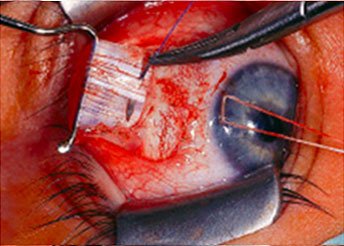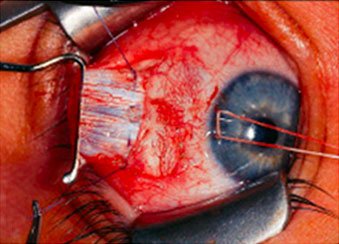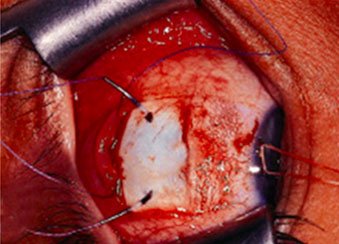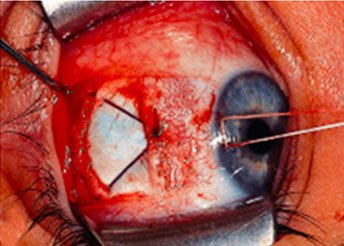
Is Surgery the Solution?
What its Strabismus?
- Strabismus is a misalignment of eyes.
- There a number of “laymen” terms: Lazy eye, crossed eye, wandering eye…
- Strabismus is a general terms that encompasses many forms of Ocular Misalignment.
Types of Strabismus:
- Eso-tropia: Eyes turning in
- Exo-tropia: Eyes turning out
- Vertical deviation: Hyper-tropia / Hypo -tropia
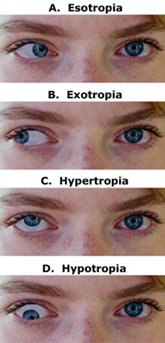
- Sometimes strabismus presents as a compensating head tilt. Surgical correction often treats the head tilt. This is true for both children and adults.
- Sometimes a perceived strabismus is Pseudo-Strabismus
- Strabismus can have patterns – such as “A” or “V”
- These “patterns” are a sign of early (infantile) interruption of binocular vision development.
- The deviation & pattern can be surgically corrected.
What is Binocular Vision? What is Amblyopia? & What is their relationship to Double Vision?
- Each eye views objects at slightly different angle, from which the brain creates a 3-dimensional image. This requires perfect alignment of the eyes.
- In childhood, the brain has the capacity to ignore the image from a misaligned eye, avoiding double vision. But the cost is a “lazy eye” – which if not treated in timely fashion, will result in poor vision for life.
- When misalignment develops in adulthood, the brain is not able to suppress the double vision.
- The difference between two individuals who have misaligned eyes, one with double vision & the other without double vision, is the age at which the problem began.
Why does strabismus occur in adults?
- Most commonly it due to the deterioration or recurrence of a childhood problem.
- Other causes include: stroke, auto immune disorders, and orbital injuries.
Am I too old to have my strabismus corrected?
- No. In general it is never too late for surgical correction.
What if I already had an eye muscle operation in the past?
- Re-operation is possible, & generally successful.
I am an Adult …Why go to a Pediatric Ophthalmologist?
- The most common causes of strabismus in adults are:
Untreated childhood strabismus
Deterioration of a childhood problem
Recurrence of a treated childhood problem. - All Pediatric Ophthalmologists are initially trained as an Adult Ophthalmologist, and subsequently specialize in the combined field of Pediatric Ophthalmology & Strabismus.
- Strabismus is more common in children than adults. As such Pediatric ophthalmologists have the most expertise in dealing with ocular misalignment in all age groups

Is strabismus surgery considered cosmetic?
- Numerous studies have confirmed that strabismus is not simply a cosmetic problem.
- When ocular deviation is pronounced it becomes a communication disorder – affecting relationships, job performance, and psychological health.
- In some, surgery restores binocular function and expands the visual field back to normal.
- When there is constant double vision, it is often so disabling that patients have to resort wearing a patch on one eye to function.
I heard Botox can be used for the eye muscles. Is this True?
- Botox® (Botulinum Toxin) was initially developed and tested by Alan Scott MD for the treatment of Strabismus.
- It’s use as an agent to smooth wrinkles came a decade later.
- The effect wears off in time, and outcomes can at times be unpredictable: as such its use is limited.
- In selected individuals it is quite effective, but in general is not a replacement for surgery.
What are the most common risks? What are the most serious complications?
- Surgery may not fully address the deviation, and there may be long term shifts, producing over-corrections or under-corrections.
- Studies suggest up to 20% of childhood cases may require a future re-operation.
What are adjustable sutures?
- An Adjustable suture is a special type of slip knot, used at the time of surgery, to hold an eye muscle in place.
- This technique allows the surgeon to adjust the eye position in the first 24 hours after an operation.
- Thus over or under-corrections in the immediate postoperative period can be addressed without requiring a re-operation.
What happens during eye muscle surgery?
- Surgery is generally done as an Outpatient (No hospital stay)
- There is no Skin incision.
- Access to the eye muscles is achieved by making a small opening (~1cm) and stretching the conjunctiva to expose and operate on the eye muscle(s)
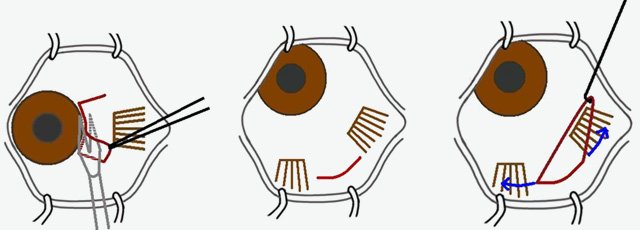
- Surgery is generally performed under anesthesia.
- Once the eye muscle is exposed, a hook is placed beneath the muscle insertion and a suture is passed close to the insertion of the muscle.
- The eye muscle is disinserted and moved to a new position.
